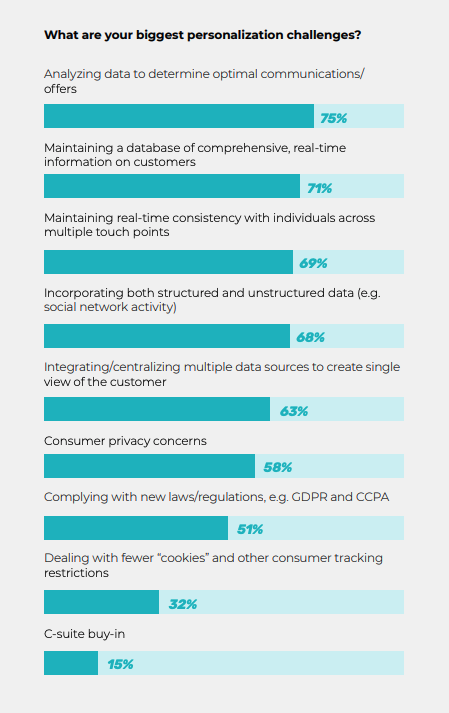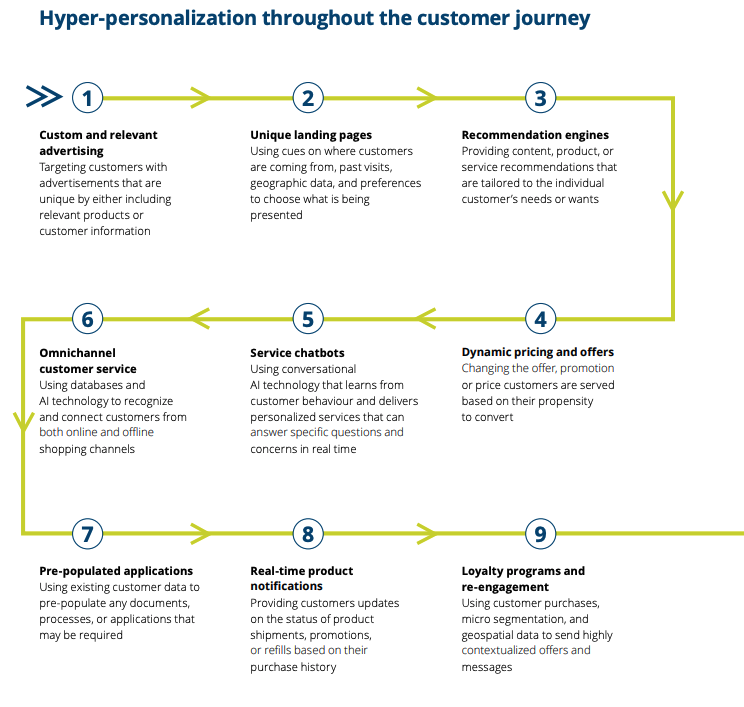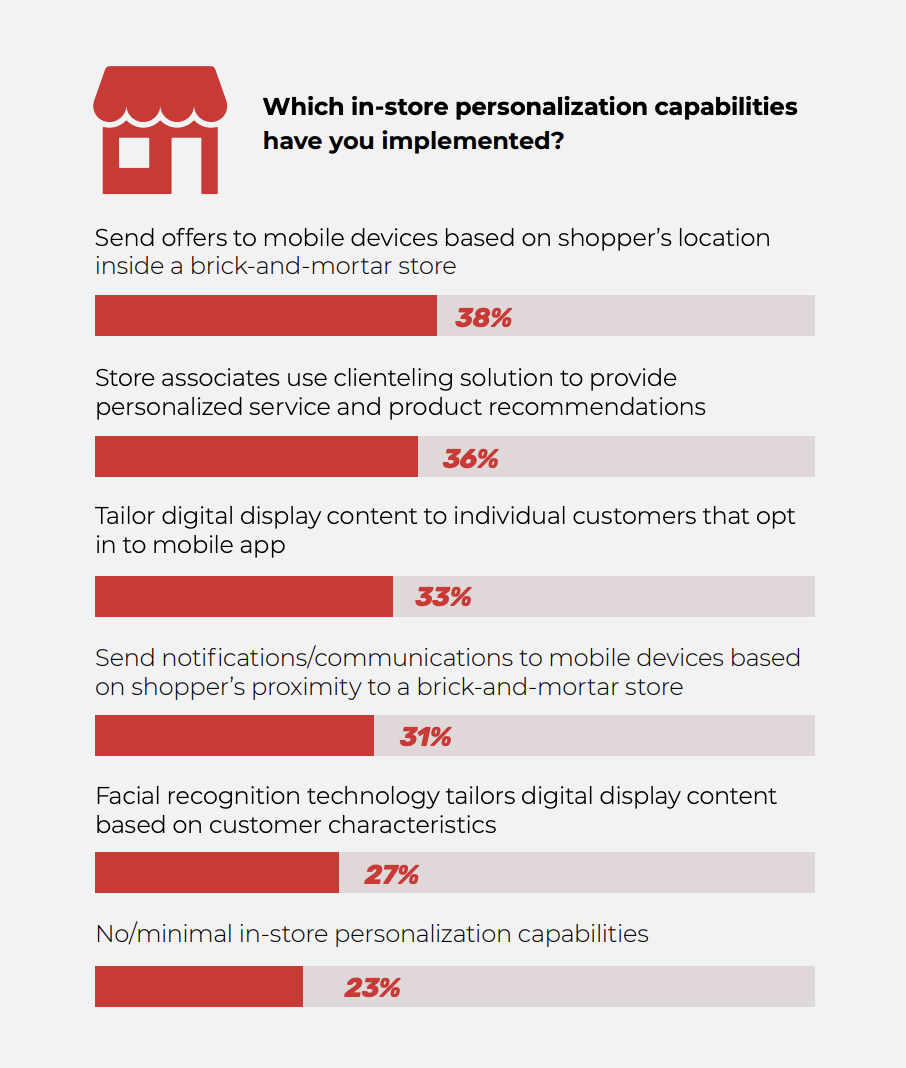Staffing shortages, shipping delays, and out-of-stocks are plaguing the retail industry. And now, shoppers hit with inflation are putting a premium on competitive pricing.
But rather than throwing up their hands and just living with it, retailers can fight back—and win market share—by improving the customer experience. But routine measures aren’t enough. It’s time to push the envelope with a new trend that’s taking hold: hyper-personalization.
Personalization influences most online shoppers:
- 84% of online shoppers report that personalization influences their purchases
- 88% of online shoppers are more likely to continue shopping on a retailer website offering a personalized experience
- 41% of online shoppers are willing to share personal information to gain a more personalized experience
Source: https://www.retailcustomerexperience.com/news/personalization-influencing-most-online-shoppers/
If personalization means making customers feel special and appreciated, then hyper-personalization demands that retailers broaden their efforts and plow more energy into personalizing than ever before. Whereas ordinary personalization measures may be limited to inserting a person’s name in an email message, thanking them for their latest purchase, or acknowledging their purchase history, this is merely a starting point for hyper-personalization, which tracks real-time browsing, search, and shopping behaviors to identify individual needs and desires and uses that information to establish meaningful, one-to-one relationships with customers.

Hyper-Personalization: Basic Tenets
Here are the basic tenets of successful hyper-personalization:
- Treat customers as individuals
- Keep your promises
- Earn customers’ trust
- Show appreciation for their business
- Maintain open, sincere communication
- Ensure your entire organization is committed to the importance of human engagement at every possible touchpoint
Most retailers are already using data to personalize some of their marketing activities. For instance, inserting a customer’s name in an email greeting or discount coupon or website landing page; using texts or emails to thank customers for a recent purchase; and making recommendations for future purchases based on a shopper’s history.
Engaging customers in these ways certainly helps boost their relationship with your brand. But in today’s highly competitive, sometimes volatile, post-pandemic market, retailers must step up their game. Engagements must be based on a thorough understanding of each shopper’s intricate browsing, buying, and communication behavior on any channel and at every touchpoint, and using that knowledge to stay relevant, and to show shoppers you are genuinely interested in fulfilling their needs and value their business.
A Deloitte report on hyper-personalization says, “Customers expect to be treated as individuals, as human beings… They want to deal with companies who understand who they are and what they’re going through—and who appreciate that their reality and needs are changing every single day.”
In other words, hyper-personalization demands that retailers be hyper-customer-centric.
In acknowledging customers’ distinctly different experience preferences, brands can use hyper-personalization to customize and streamline the customer journey and create a high level of purchase satisfaction. But doing so requires a deeper dive into data collection, encompassing both online and offline shopping.
How do retailers get going on the path to hyper-personalization? What are the key elements that will serve as the foundation for hyper-personalizing the customer experience?

Take A Deeper Data Dive
Establishing a deeper connection with customers requires a deeper dive into data, using more sophisticated automation. This may require accessing, collecting, and sorting data with tools powered by artificial intelligence (AI), machine learning, and sophisticated predictive technology. Merging offline and online data can deliver a holistic view of every customer along their path to purchase, thus enabling the high level of customization that hyper-personalized customer interactions require.

It is also reasonable to assume that zero-party data—data that a customer proactively and deliberately shares—is essential for hyper-personalization to work. Of course, this opens up some compliance challenges. “Businesses need to make sure that they have consent – and the functionality for individuals to change their minds at any time.”
Consent is a basic starting point for tracking a customer’s interactions, identifying patterns, analyzing responses, and continually gaining insights into what a customer wants, when they want it, and how best to deliver it. Make sure you’re up to speed on the laws impacting your business and that your processes comply with those.
Embrace Advanced Tools
As retailers consider innovative technology designed to forward hyper-personalization, they need to think differently about the purpose and role of stores in serving customers. The store is no longer a mere destination but a brand experience. At a minimum, the instant a customer comes through your door, they should have access to product information and recommendations on their mobile device.
To deliver a hyper-personalized experience, focus on these four tech-enabled elements:
1. Analyze customer behaviors with smart cameras
Smart cameras can assist retailers in refining store layouts, adjusting displays for optimal customer interactions, and reducing checkout wait times.
2. Gather demographic information with advanced AI
AI has many uses for retailers, such as taking accurate customer counts throughout the day. Use the findings to predict staffing needs and identify subsets of customers who visit the store at certain times, allowing you to make real-time decisions to personalize their experience with special displays, coupons, and discount rewards.
3. Improve signage accuracy with ESL
Electronic shelf labels (ESL) are a time-saver compared to analog labels. The latest pricing and product information can be sent to an ESL fast, and the labels can incorporate enticing visuals and promotional messages.
4. Manage on-hand inventory
Sensors, smart cameras, and Wi-Fi can help track inventory, so you keep shelves stocked with preferred items. Reduce excess inventory by enabling dynamic pricing and pushing special offers via text messaging to customers’ mobile devices.
Get Associates Involved with Clienteling
Clienteling is a form of hyper-personalization that supports the development of authentic, one-to-one relationships between customers, associates, and your brand. The strategy entails a commitment to giving sales associates access to all pertinent information about a customer. With this data, associates can be better prepared for and available to customers—both online and in store—to answer questions, help them find products, confirm orders, and suggest related products and accessories that fit each customer’s interests.
Clienteling has traditionally referred to the personal, one-on-one service that a retail salesperson provides to a fashion customer. In today’s digital mode, a retail associate can lead clients to virtual brand experts, like MarketSource’s AskMe™ representatives, who are on standby to display, demonstrate, and help customers explore items in real-time through video chat. They can answer detailed questions about each item and share links to suggested products that fit the customer’s preferences. Interactive touch screens can play a role in clienteling, too.
Associates can maintain involvement and establish meaningful interactions, even if the customer visits another store location, and should aim to obtain customer feedback so they continually improve the quality of their service.
AskMe helps brands deliver a hyper-personalized experience and can be a key component of a well-rounded clienteling strategy that makes a lasting impact on the customer.
Equipping retail associates with the right tech tools can make all the difference when it comes to building true human relationships at scale. A Retail Touchpoints report, Clienteling Grows Up: How Retailers of all Kinds are Leveraging Tech to Deliver One-to-One Personalization, advises retailers to take the following steps to do this effectively:
Centralize and then contextualize consumer data to turn insights into tools to build customer connections. Focus on the customers most interested in and likely to respond positively to a long-term relationship and have the greatest lifetime value potential.
Deploy new technologies intelligently to deliver on the mantra of “right message, right channel, right time.” Advances in mobile technology, machine learning, and artificial intelligence now make it possible to offer this kind of high-touch service at scale.
Arm associates with the tech and training they need to deliver better and continually improved customer experiences. Empowering employees to play a more meaningful role in customer engagement is also an effective retention tactic.
Think about it: Every customer comes into your store carrying a smart device, so why shouldn’t your associates do the same?

- 38% of retailers can send offers to mobile devices based on a shopper’s location within a brick-and-mortar store
- 31% of retailers can send notifications based on a shopper’s proximity to a store
The Case for Hyper-Personalization
A thoughtfully programmed hyper-personalization strategy—one that is supported with automated workflows and streamlined data analysis—can bring great results. It enables retailers to:
- Increase conversions
- Maximize revenue
- Improve customer lifetime value
- Increase customer loyalty
- Reduce customer acquisition and retention costs
- Increase store traffic
- Elevate the customer experience
Don’t expect these results all at once. Start slowly, perhaps by optimizing your online/offline channel connection. As you develop deeper relationships with current customers, and your brand begins to embed hyper-personalized services into the customer journey, you can use your efforts to attract new customers.
And remember that positive impressions travel fast: Customers who feel genuinely appreciated and know they are valued are more likely to recommend your store to their friends and family.
Ready to talk?
We can create your ultimate hyper-personalization strategy to help you win more customers and accelerate sales.


